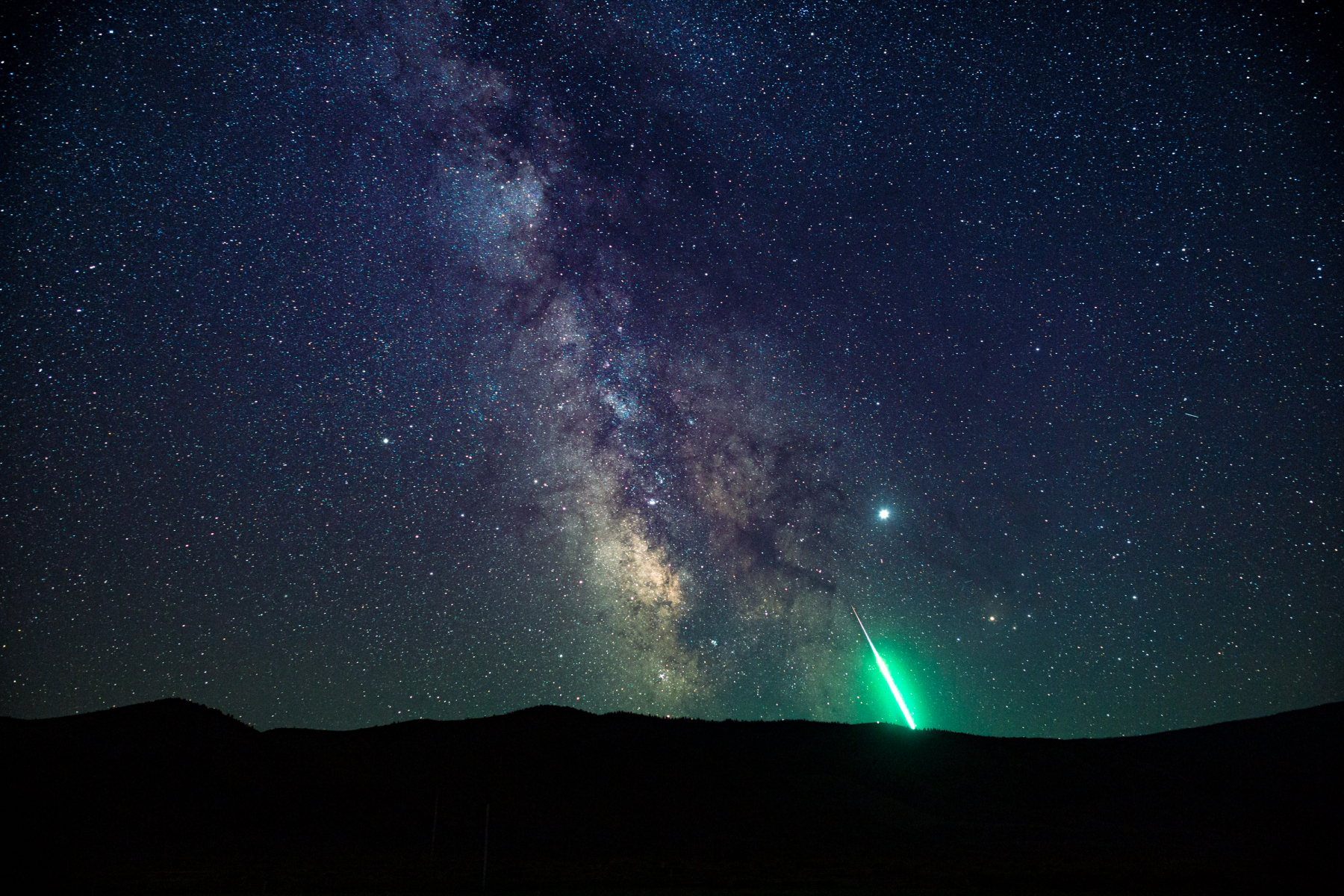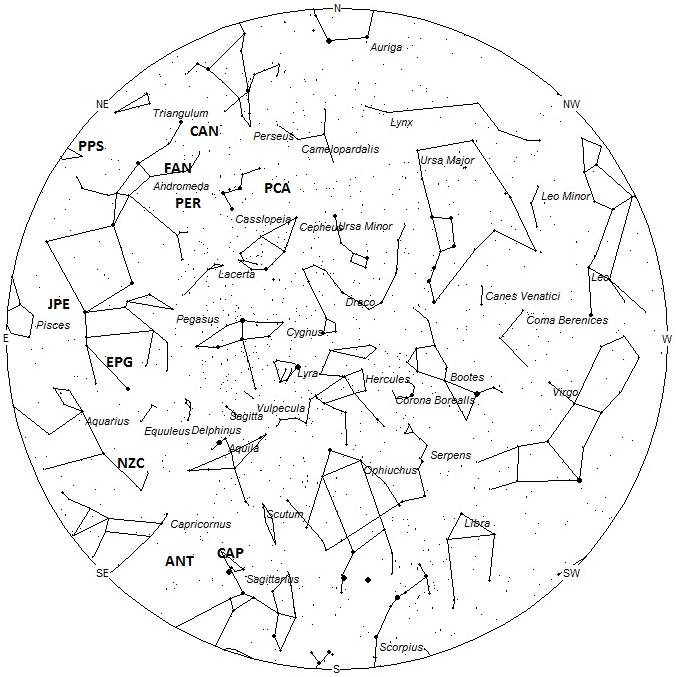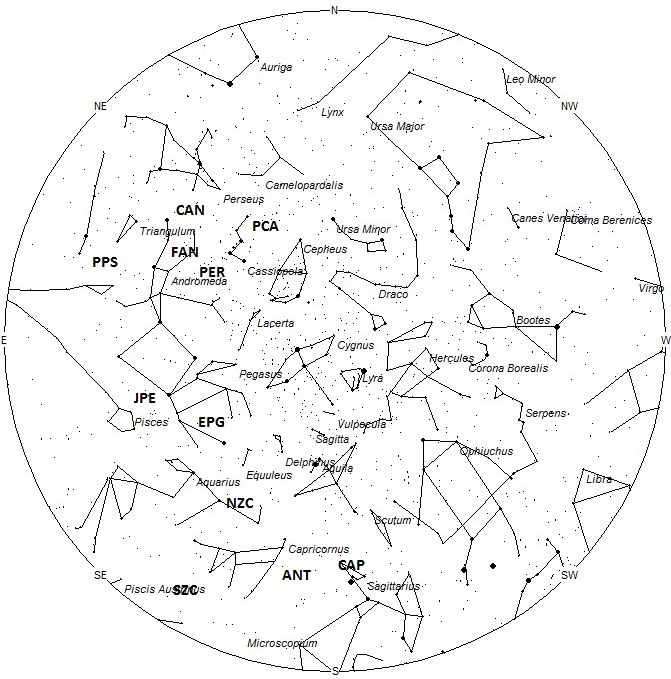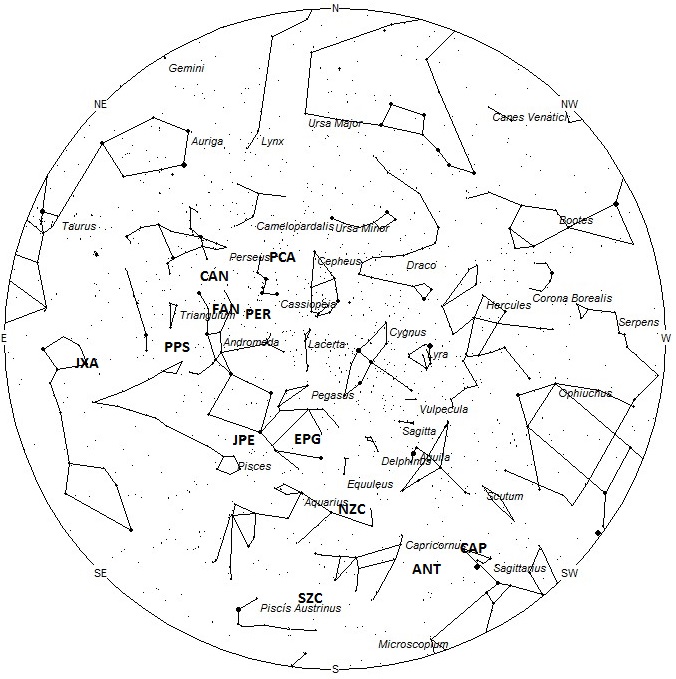 Jason Ptaszek captured this fantastic green fireball at 08:15 Universal Time on 2019 July 1 from Summer Lake, Oregon USA. Refer to IMO Fireball Report #2847-2019 © Jason Ptaszek
Jason Ptaszek captured this fantastic green fireball at 08:15 Universal Time on 2019 July 1 from Summer Lake, Oregon USA. Refer to IMO Fireball Report #2847-2019 © Jason PtaszekDuring this period the moon reaches its full phase on Tuesday July 16th. On that date the moon is located opposite the sun in the sky and remains above the horizon all night long. This weekend the waxing gibbous moon will set during the morning hours just before dawn, allowing a small opportunity to view under dark skies. The estimated total hourly meteor rates for evening observers this week is near 2 no matter your location. For morning observers the estimated total hourly rates should be near 8 no matter your location. The actual rates will also depend on factors such as personal light and motion perception, local weather conditions, alertness and experience in watching meteor activity. Rates are reduced during this period due to moonlight. Note that the hourly rates listed below are estimates as viewed from dark sky sites away from urban light sources. Observers viewing from urban areas will see less activity as only the brightest meteors will be visible from such locations.
The radiant (the area of the sky where meteors appear to shoot from) positions and rates listed below are exact for Saturday night/Sunday morning July 13/14. These positions do not change greatly day to day so the listed coordinates may be used during this entire period. Most star atlases (available at science stores and planetariums) will provide maps with grid lines of the celestial coordinates so that you may find out exactly where these positions are located in the sky. A planisphere or computer planetarium program is also useful in showing the sky at any time of night on any date of the year. Activity from each radiant is best seen when it is positioned highest in the sky, either due north or south along the meridian, depending on your latitude. It must be remembered that meteor activity is rarely seen at the radiant position. Rather they shoot outwards from the radiant so it is best to center your field of view so that the radiant lies at the edge and not the center. Viewing there will allow you to easily trace the path of each meteor back to the radiant (if it is a shower member) or in another direction if it is a sporadic. Meteor activity is not seen from radiants that are located below the horizon. The positions below are listed in a west to east manner in order of right ascension (celestial longitude). The positions listed first are located further west therefore are accessible earlier in the night while those listed further down the list rise later in the night.
These sources of meteoric activity are expected to be active this week.
The list below offers the information from above in tabular form. Rates and positions are exact for Saturday night/Sunday morning except where noted in the shower descriptions. Details of each source will continue next week when viewing conditions are more favorable.
| SHOWER | DATE OF MAXIMUM ACTIVITY | CELESTIAL POSITION | ENTRY VELOCITY | CULMINATION | HOURLY RATE | CLASS |
| RA (RA in Deg.) DEC | Km/Sec | Local Summer Time | North-South | |||
| alpha Capricornids (CAP) | Jul 27 | 19:16 (289) -13 | 22 | 01:00 | <1 – <1 | II |
| Anthelion (ANT) | – | 20:16 (304) -19 | 30 | 02:00 | 1 – 2 | II |
| Northern June Aquilids (NZC) | Jul 03 | 21:20 (320) -02 | 41 | 03:00 | 1 – 1 | IV |
| Southern June Aquilids (SZC) | Jul 06 | 21:51 (328) -25 | 39 | 04:00 | <1 – 1 | IV |
| epsilon Pegasids (EPG) | Jun 15 | 22:12 (333) +14 | 28 | 04:00 | <1 – <1 | IV |
| July Pegasids (JPE) | Jul 11 | 23:24 (351) +12 | 68 | 05:00 | <1 – <1 | IV |
| Perseids (PER) | Aug 13 | 00:20 (005) +50 | 59 | 06:00 | <1 – <1 | I |
| 49 Andromedids (FAN) | Jul 21 | 01:12 (018) +46 | 60 | 07:00 | <1 – <1 | IV |
| phi Piscids (PPS) | Jul 05 | 01:16 (026) +28 | 67 | 07:00 | 1 – <1 | IV |
| psi Cassiopeiids (PCA) | Jul 22 | 01:26 (022) +71 | 42 | 07:00 | <1 – <1 | IV |
| c-Andromedids (CAN) | Jul 09 | 02:17 (034) +50 | 58 | 08:00 | 1 – <1 | IV |
| July chi Arietids (JXA) | Jul 13 | 02:26 (036) +09 | 69 | 08:00 | 1 – 1 | IV |







 You saw something bright and fast? Like a huge shooting star? Report it: it may be a fireball.
You saw something bright and fast? Like a huge shooting star? Report it: it may be a fireball.  You counted meteors last night? Share your results with us!
You counted meteors last night? Share your results with us!  You took a photo of a meteor or fireball? You have a screenshot of your cam? Share it with us!
You took a photo of a meteor or fireball? You have a screenshot of your cam? Share it with us!  You caught a meteor or fireball on video? Share your video with us!
You caught a meteor or fireball on video? Share your video with us!
One comment
Been an amateur astronomer since 1995. Have been using FM forward-scatter to listen to meteor showers for the past several years! Comes in handy here in the Pacific Northwest, with many cloudy nights…